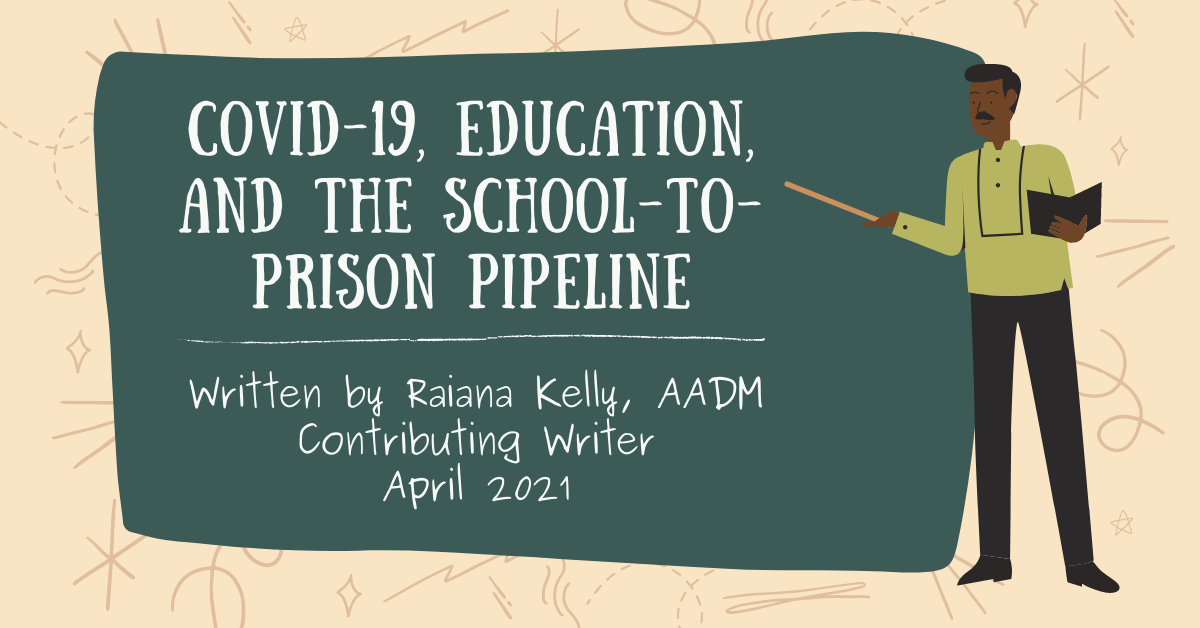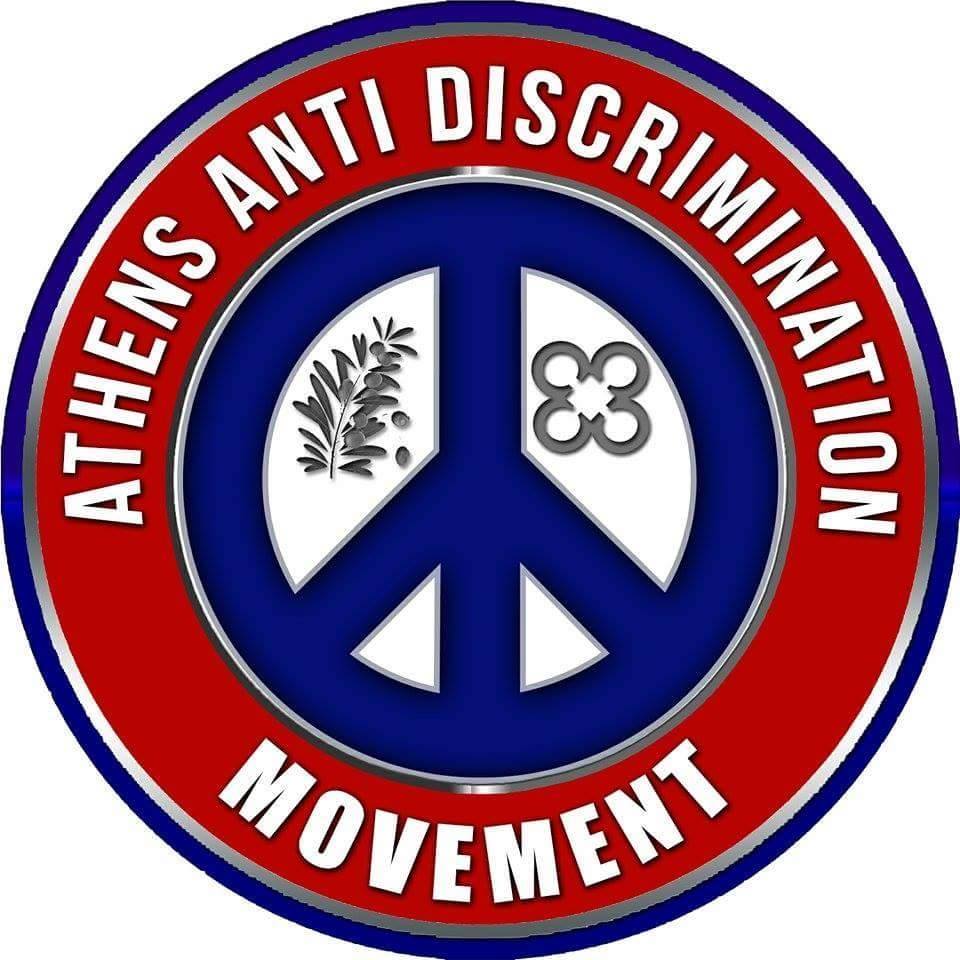
Written by Raiana Kelly, AADM Contributing Writer
April 2021
COVID-19, Education, and the School-to-Prison Pipeline
COVID-19 and the transition to virtual learning has impacted students everywhere, especially more vulnerable populations of students, including minority students, low-income students, and students with disabilities. Prior to COVID-19 and the transition to virtual learning, these populations already faced academic and economic disparities, and COVID-19 has not improved the issues these populations face, including the school-to-prison pipeline.
What is the School-to-Prison Pipeline?
The school-to-prison pipeline refers to the process in which students are funneled out of school and into the criminal justice system. It is a result of zero-tolerance disciplinary policies that mandate pre-determined punishments for student misconduct regardless of the circumstances, and the presence of law enforcement officers in schools that handle issues that should be handled by the school administration.
The school-to-prison pipeline disproportionately affects minority students and students with disabilities. Black and Hispanic students are far more likely to be suspended or expelled for the same misconduct as their white peers. Societal inequities, such as living in poverty, food insecurity, and poor mental health care also contribute to social and behavioral problems in school. These societal inequities result in students acting out and being punished and/or arrested for their actions.
These punitive justice measures isolate students and remove them from the learning environment, and studies have shown that juvenile incarceration does not decrease youth from reoffending and may increase recidivism rates. Additionally, students that are removed from the classroom as a disciplinary measure are more likely to repeat a grade, drop out of school, and/or become involved in the juvenile justice system.
To read more about the school-to-prison pipeline, click here.
How has COVID-19 Impacted Education and the School-to-Prison Pipeline?
Despite students being out of school and participating in virtual learning, the school-to-prison pipeline persists. In 2020, a 15 year old student was arrested for not completing their homework, a 12 year old student had police sent to their home for playing with a toy Nerf gun on camera, and a 9 year old was suspended for 6 days after a teacher saw a BB gun in the background of their home.
There are also new rules in place for virtual learning, including whether or not cameras must be turned on during lessons, what clothing or hairstyles are permitted, eating during class, and more. These rules leave students subject to school disciplinary actions even while learning from home.
COVID-19 has impacted our communities in a variety of ways, and there will be long-lasting effects on our youth, especially if students return to in-person learning with unresolved trauma and a lack of, or no access, to mental health care. Without access to qualified mental health professionals and counselors, we may see an increase in disruptive behaviors that result in the removal of students from the classroom, and the perpetuation of the school-to-prison pipeline.
Recommended Solution: Restorative Justice & Policy Changes
Studies have shown that greater educational achievement leads to reduced crime and incarceration levels, so it doesn’t make sense to punish children for misbehaving by removing them from school through suspension, expulsion, and relocation to juvenile detention centers.
This doesn’t mean that schools should not enforce rules; it just means that the rules, and the disciplinary measures that enforce them, need to be designed in a way that considers the needs of all students, the long-term impacts they have, and should be adaptable and include second chances. We need to replace the current punitive justice measures with restorative justice practices and introduce policy changes aimed at eliminating the school-to-prison pipeline to ensure that students remain in school and have the greatest chance at success.
Some policy changes have already been introduced. In 2020, the U.S. Senate and House of Representatives introduced the Counseling not Criminalization in Schools Act. This act would discourage the use of zero tolerance disciplinary policies, and divert funding from supporting the presence of police in schools. Instead, the act would support evidence-based and trauma-informed services to address the needs of marginalized students and improve academic outcomes. This means that students would be under less surveillance, less likely to be arrested or removed from the learning environment, and more likely to stay in school. Since the 116th Congress introduced the bill, it’s now up to the 117th Congress to get their version of the bill passed in both Chambers so that President Biden may sign it into law.
In California, the Oakland Unified School District (OUSD) has had great success using a restorative justice approach. Within 3 years of instituting the program at a failing middle school, they saw a decrease in school suspensions by 87% and a corresponding decrease in violence. By 2011, the OUSD expanded the program to cover the entire school district and restorative justice is now the new model for handling disciplinary problems.
Restorative justice focuses on prevention, intervention, and reintegration rather than punishment. It addresses and discusses the needs of the school community, fosters healthy relationships between educators and students, prevents and reduces harmful behavior, restores positive relationships, and resolves conflict by holding individuals and groups accountable for their actions.
To read more about restorative justice, click here.
Conclusion
COVID-19 will have a long-lasting impact on students, but we can help reduce the impact it will have on their academic success. As more schools across the country return to in-person learning, we need to focus on several things.
- Intensive tutoring in core subjects to get students caught up from COVID-19 related learning loss.
- All students need access to mental health care in order to mitigate disruptive behaviors that may result from unresolved trauma. This can be accomplished by schools hiring qualified counselors and mental health professionals.
- Prioritize and push for restorative justice practices in place of punitive justice measures. We need to create policies and initiatives that both address and work to eliminate the school-to-prison pipeline.
